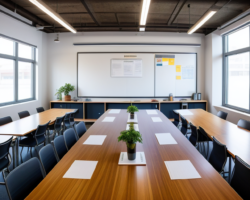Working from home is now more common than ever, and with it comes the need for a designated workspace. But what if you and your partner both work from home? Designing a home office for two may seem like a daunting task, but with the right strategies, it can be a seamless and productive endeavor. In this blog post, we’ll explore shared workspace ideas for creating a functional and inspiring home office for two. From choosing the right layout to establishing boundaries for productivity, we’ll cover all the essential aspects of designing a shared workspace. Whether you and your partner are both working from home full-time or just need a designated spot for occasional tasks, these tips will help you create a harmonious and efficient home office for two. So, let’s dive in and explore how to make your shared workspace a space that fosters productivity and creativity.
Choosing the Right Layout
When it comes to designing a workspace, the layout is a crucial factor that can greatly impact productivity and comfort. A well-designed layout can enhance the flow of work and optimize the use of space, while a poor layout can lead to clutter and inefficiency. It’s important to consider the specific needs and requirements of the tasks that will be carried out in the space when choosing the right layout.
One of the key factors to consider when choosing the right layout is the functionality of the workspace. Whether it’s a home office or a corporate environment, the layout should be tailored to accommodate the tasks that will be performed. For example, if the space will be used for creative work, it may be beneficial to have an open layout that allows for collaboration and brainstorming. On the other hand, if the work involves concentration and focus, a more private and enclosed layout may be more suitable.
Another important consideration when selecting the right layout is the ergonomics of the workspace. The arrangement of furniture and equipment should prioritize comfort and efficiency. This includes factors such as the placement of desks, chairs, and other work tools to minimize strain and promote good posture. A well-thought-out layout can contribute to a healthy and productive work environment.
Ultimately, the right layout for a workspace should strike a balance between functionality, aesthetics, and comfort. By taking into account the specific requirements of the tasks at hand and optimizing the arrangement of furniture and equipment, a well-chosen layout can contribute to a pleasant and efficient work environment.
Setting Up Separate Workstations
When setting up your workspace, it’s important to consider the layout and functionality of the area. One key aspect to focus on is setting up separate workstations for different tasks. This can help to minimize distractions and create a more efficient work environment. By having dedicated areas for specific tasks, such as a writing desk, a computer desk, and a crafting table, you can better organize your space and increase productivity.
Having separate workstations allows you to mentally transition between different tasks and maintain a sense of focus. For example, if you have a designated area for computer work, you can create a more ergonomic setup with the appropriate chair and monitor height. Similarly, a designated area for crafting or art projects can be equipped with the necessary supplies and tools to support those activities.
In addition, by setting up separate workstations, you can also reduce clutter and optimize the use of space. Each workstation can be tailored to the specific needs of the task at hand, allowing for better organization and efficiency. This division of space can also help to create a sense of boundary between different work activities, which can be especially beneficial for those working from home.
Overall, setting up separate workstations in your workspace can contribute to improved productivity, organization, and overall work satisfaction. By carefully planning and designing the layout to accommodate different work tasks, you can create a more harmonious and functional environment that supports your professional and creative endeavors.
Creating a Harmonious Color Scheme
When designing a workspace, one of the most important aspects to consider is the color scheme. Colors have a profound impact on our mood and productivity, so it’s essential to choose the right combination for a harmonious atmosphere.
Neutral colors like white, beige, and light gray provide a clean and serene backdrop for a workspace. These colors can help create a sense of calm and clarity, which is ideal for focusing on tasks and minimizing distractions.
Adding a pop of color through accents or accessories can inject energy and creativity into the space. Bold colors like red, yellow, or blue can be used sparingly to add visual interest without overwhelming the senses.
It’s also important to consider the psychological effects of different colors. For example, blue is often associated with tranquility and productivity, making it a great choice for an office space. On the other hand, yellow is known to promote optimism and creativity, making it a good option for a design or creative studio.
Utilizing Natural Light
One of the most important factors to consider when designing a workspace is utilizing natural light. Natural light not only brightens up a space, but also has positive effects on productivity and mood. To make the most of natural light in your workspace, position your desk near a window. This will allow you to take advantage of the sunlight during the day, reducing the need for artificial lighting.
Additionally, consider using light, airy window treatments that allow the maximum amount of natural light to filter into the room. Avoid heavy drapes or curtains that can block out sunlight, and instead opt for sheer fabrics or blinds that can be easily adjusted to control the amount of light entering the space.
Another way to utilize natural light in your workspace is to incorporate reflective surfaces, such as mirrors or glass, to bounce light around the room. By strategically placing these surfaces, you can amplify the effects of natural light and create a brighter, more inviting work environment.
In conclusion, utilizing natural light in your workspace is essential for creating a bright, energizing atmosphere that can have a positive impact on your productivity and well-being. By following these tips and incorporating natural light into your workspace design, you can create a space that is both functional and enjoyable to work in.
Incorporating Storage Solutions
When designing a workspace, it’s important to consider storage solutions to keep the area organized and clutter-free. This can be achieved through the use of shelving units, filing cabinets, or storage bins to house office supplies, paperwork, and other essentials.
One effective storage solution is to utilize vertical space by installing wall-mounted shelves or bookcases. This allows for easy access to items while keeping the floor space clear for movement and other furniture. Additionally, the use of clear bins or labeled baskets can make it easier to identify and access stored items.
Another way to incorporate storage solutions into the workspace is to choose furniture pieces that have built-in storage, such as desks with drawers or ottomans with hidden compartments. This not only maximizes space but also adds functionality to the furniture.
Overall, the incorporation of thoughtful storage solutions can contribute to a more organized and efficient workspace, ultimately enhancing productivity and reducing the stress of a cluttered environment.
Personalizing the Workspace
Personalizing your workspace is an important aspect of creating a productive and comfortable environment. When you have a space that reflects your personality and style, you are more likely to feel motivated and inspired to work. Whether you prefer a minimalistic design or a cozy and eclectic space, incorporating elements that are meaningful to you can greatly enhance your overall work experience.
One way to personalize your workspace is by adding artwork or decorative pieces that speak to your interests and values. This could be anything from a favorite painting or photograph to a collection of meaningful objects that inspire you. Surrounding yourself with items that bring you joy can help create a positive work atmosphere.
Additionally, you can customize your workspace with furniture and accessories that cater to your specific needs. This could mean investing in a comfortable ergonomic chair, a stylish desk organizer, or even a plant or two to bring a touch of nature indoors. Creating a space that is functional and visually appealing can make your work environment feel like a place that is truly your own.
Another way to personalize your workspace is by adding personal touches such as family photos, inspirational quotes, or mementos from your favorite travels. These small details can serve as reminders of what is important to you and can provide moments of encouragement during busy workdays. By infusing your space with elements that are meaningful to you, you can create a workspace that is both professional and personal.
Establishing Boundaries for Productivity
Establishing boundaries for productivity is essential for maintaining a healthy work-life balance. When working from home, it can be easy to blur the lines between personal and professional life, leading to decreased productivity and increased stress. One of the first steps in establishing boundaries is to designate a specific area in your home for work. This separate workspace can help create a physical boundary between your professional and personal life.
Another important boundary to set is your working hours. Just because you are working from home doesn’t mean you should be available 24/7. Set specific work hours and stick to them, avoiding the temptation to check emails or work on projects outside of these designated times. This can help prevent burnout and ensure that you have time for other activities and relationships outside of work.
It’s also important to establish boundaries with your family or housemates. Communicate with them about your work schedule and the importance of uninterrupted work time. This can help minimize distractions and interruptions, allowing you to focus on your tasks and be more productive during work hours.
Lastly, establishing boundaries also means knowing when to stop working. It can be easy to let work spill over into your personal time when you’re working from home, but it’s important to have a clear boundary between work and leisure. Set a specific time to finish work each day, and once that time arrives, shut down your computer and mentally switch off from work mode.





